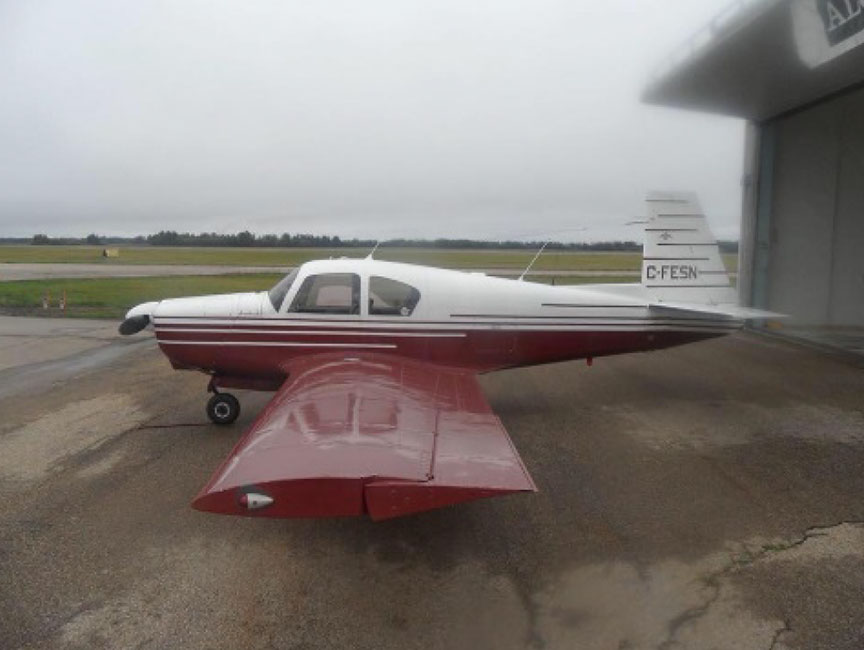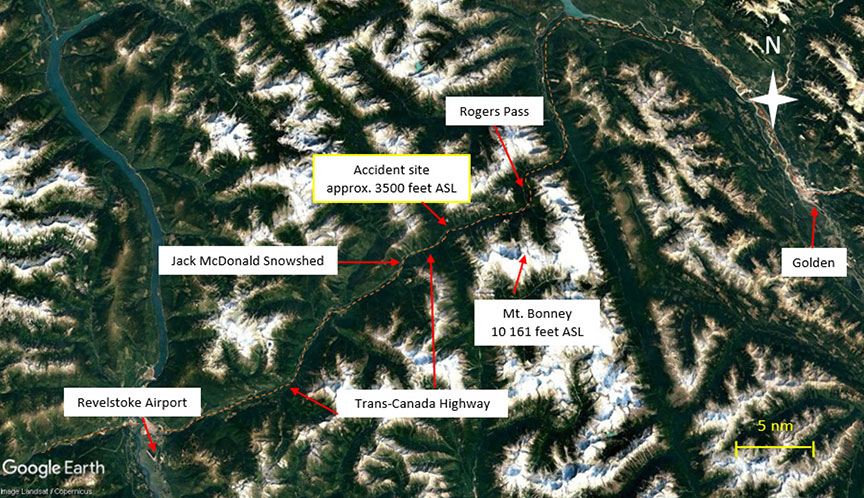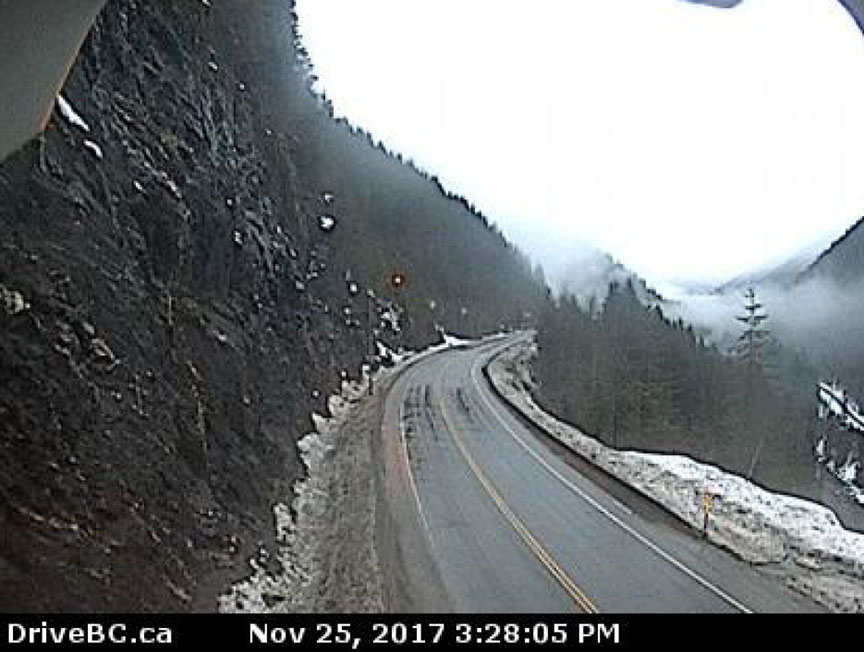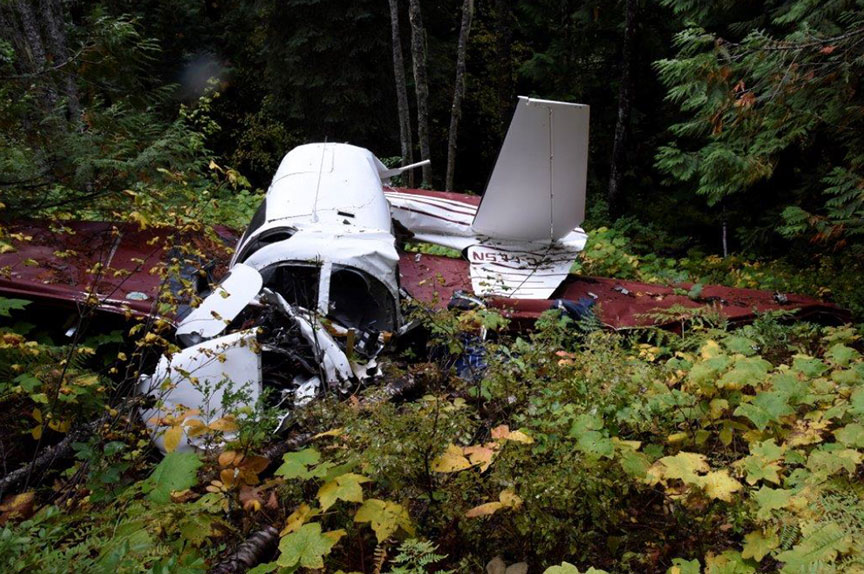Visual flight rules flight into deteriorating weather and collision with terrain
Mooney M20D, C-FESN
Revelstoke, British Columbia, 26 nm NE
The Transportation Safety Board of Canada (TSB) investigated this occurrence for the purpose of advancing transportation safety. It is not the function of the Board to assign fault or determine civil or criminal liability. This report is not created for use in the context of legal, disciplinary or other proceedings. See Ownership and use of content. Masculine pronouns and position titles may be used to signify all genders to comply with the Canadian Transportation Accident Investigation and Safety Board Act (S.C. 1989, c. 3).
History of the flight
At 1422Note de bas de page 1 on 25 November 2017, the privately registered Mooney M20D aircraft (registration C‑FESN, serial number 192) (Figure 1) departed from Penticton Airport (CYYF), British Columbia, with 2 people on board, for a visual flight rules (VFR) flight to Edmonton/Villeneuve Airport (CZVL), Alberta. After departure from CYYF, the aircraft climbed to an altitudeNote de bas de page 2 of approximately 9800 feet above sea level (ASL) to cross the Columbia Mountain Range while heading directly toward Revelstoke Airport (CYRV), British Columbia. At approximately 1510, while over CYRV, the aircraft made four 360° left turns while descending to approximately 4200 feet ASL. The aircraft then flew along the Trans-Canada Highway, heading east towards Rogers Pass (Figure 2). While the aircraft was following the highway, its height above ground level (AGL) varied between 1200 feet and 3300 feet. At approximately 1527, the aircraft passed the Jack McDonald Snowshed at 5200 feet ASL (approximately 2300 AGL), travelling at 131 knots. The final 2 global positioning system (GPS) track points, which were very close to the accident site, indicated that the aircraft's airspeed had slowed from 147 knots to 82 knots and the aircraft had climbed from approximately 1710 feet AGL to 2550 feet AGL in 11 seconds.
Search and rescue
At 2240, the Joint Rescue Coordination Centre (JRCC) in Victoria, British Columbia, was notified that the aircraft had not arrived at CZVL and was missing. Search-and-rescue efforts were begun, but were hampered by poor weather conditions. When the weather improved, the search-and-rescue operation continued, but was called off on 05 December 2017. No signal was received from the emergency locator transmitter (ELT).
On 10 September 2018, a helicopter heading to Kamloops Airport (CYKA), British Columbia, found the accident site approximately 26 nautical miles (nm) northeast of CYRV (Figure 2). The wreckage was located in Glacier National Park, approximately 500 feet north of the Trans-Canada Highway at approximately 3500 feet ASL, in a heavily forested area.
Flight planning and navigation
In the mountainous regions of British Columbia, VFR routes may be depicted on visual navigation charts (VNC) by diamonds. The occurrence flight path followed the depicted VFR route along the Trans-Canada Highway from Revelstoke toward Rogers Pass. According to the Transport Canada Aeronautical Information Manual,
The diamond marks do not imply any special level of facilities and services along the route. Pilots are cautioned that the use of the marked routes does not absolve them from proper pre-flight planning or the exercising of good airmanship practices during the proposed flight. Alternative unmarked routes are always available, the choice of a suitable route for intended flight and conditions remains the sole responsibility of the pilot-in-command.Note de bas de page 3
Many of the VFR routes on the Vancouver VNC map include cautions for pilots on the minimum altitude for course reversal. For example,
ROUTE SUBJECT TO RAPID [WEATHER] CHANGE
ALTITUDE SHOULD PERMIT COURSE REVERSAL
[MINIMUM] 5500 [FEET] ASL RECOMMENDED BETWEEN
HOPE AND PRINCETON.Note de bas de page 4
The Calgary VNC,Note de bas de page 5 which included the areas along the pilot's intended flight, did not have any cautions for the VFR route from CYRV to Rogers Pass.
The investigation was unable to determine if the pilot had intended to follow the VFR route to CZVL, as the pilot did not file a flight plan with or obtain a weather briefing from NAV CANADA prior to departure.
Meteorological information
The automated weather observation system (AWOS) special aviation routine weather report (SPECINote de bas de page 6) for CYRV indicated the following at 1501:
- winds: 210° true (T) at 3 knots, varying from 140°T to 300°T;
- visibility: 9 statute miles (sm);
- precipitation: light rain;
- few clouds at 5500 feet AGL, scattered clouds at 7400 feet, broken ceiling at 9300 feet, and overcast at 11 000 feet;
- temperature: 7 °C, dew point 2 °C;
- altimeter setting: 30.01 inHg.
The AWOS aviation routine weather report (METAR) for CYRV indicated the following at 1600:
- winds: 120°T at 4 knots, varying from 110°T to 170°T;
- visibility: 9 sm;
- few clouds at 5500 feet AGL, broken ceiling at 7100 feet, and overcast at 10 000 feet;
- temperature: 6 °C, dew point 2 °C;
- altimeter setting: 30.00 inHg.
According to the graphical area forecast (GFA) (Figure 3), the forecast for the eastern part of British Columbia—within the Rocky Mountains and along the route to CZVL—was as follows: scattered clouds based at 6000 feet ASL with tops at 8000 feet ASL; a broken layer of clouds based at 10 000 feet ASL with tops at 22 000 feet ASL; and visibility greater than 6 sm. Also, localized ceilings were forecast at 1500 feet AGL with light rain. An area near Glacier National Park and Rogers Pass was forecast to have intermittent ceilings at 800 feet AGL with mist and light rain, and the visibility was forecast to vary between 5 sm and greater than 6 sm. Sunset for Revelstoke on 25 November 2017 was at 1554.
At 1528 on 25 November 2017, local webcam photos depicted low ceilings, fog, and limited visibility due to snow near the occurrence site (Figure 4 and Figure 5).
Pilot information
Records indicate that the pilot was certified and qualified for the flight in accordance with existing regulations. He held a private pilot licence – aeroplane, which had been issued on 20 November 2015, and a valid Category 3 medical certificate. At the time of the occurrence, the pilot did not hold a night rating or an instrument rating.
The last entry in the pilot's personal logbook was made on 28 May 2017; the aircraft's journey logbook was not recovered. Therefore, the investigation was unable to determine the pilot's exact number of flight hours at the time of the occurrence. According to the logbook, up to 28 May 2017, the pilot had accumulated 122.2 total flight hours, with 1.1 hours on type and 29.8 hours as pilot-in-command.
Aircraft information
The Mooney M20D aircraft is a single-engine, 4-seat, low-wing aircraft equipped with retractable landing gear. The occurrence aircraft was manufactured in 1963 and was certified, equipped, and maintained in accordance with existing regulations and approved procedures. The aircraft was not equipped with a flight recorder, nor was it required to be by regulation.
The occurrence pilot purchased the aircraft in May 2017. The last documented maintenance of the aircraft was a 12-month inspection, which had been completed on 21 April 2017. Records indicate that as at 23 May 2017, the aircraft had approximately 3775 total airframe hours.
Accident site
The aircraft was found at approximately 3500 feet ASL, 500 feet north of the Trans-Canada Highway in a heavily forested area (Figure 6). Most of the wreckage was found at the impact location. Examination of the wreckage indicated that the aircraft struck the terrain in a steep, nose-down attitude. The slope of the hillside was approximately 25°. The flaps were found in the fully retracted (up) position. The landing gear was found in the partially extended position; however, the investigation was unable to determine if the landing gear had been selected down or if it had been extended a result of the impact forces.
All flight control surfaces were accounted for. Damage to the propeller was consistent with power being produced at the time of impact.
The aircraft's flight instruments were severely damaged. The GPS was recovered and sent to the TSB Engineering Laboratory in Ottawa, Ontario, for further examination.
The aircraft's 121.5 MHz ELT was also recovered at the accident site. The ELT's antenna was found detached from the connector, and the batteries had been ejected from the battery enclosure during the impact sequence. When initial power was applied to the ELT, it started to transmit a strong signal, which confirmed that the inertia switch was in the activated state. Due to the absence of the antenna, signal detection would have been limited to a few metres. Furthermore, without a battery, the ELT transmission would have ceased immediately.
The aircraft's engine (Avco Lycoming O-360-A1D) was removed for further examination. The engine was deemed capable of producing power at the time of impact. The left magnetoNote de bas de page 7 was found to be unserviceable and had been so for a considerable amount of time before the occurrence. This condition would have resulted in a minor reduction in engine performance.
TSB recommendations on emergency locator transmitters
The TSB has issued several recommendations on ELTs to eliminate or reduce safety deficiencies that pose significant risks. The following sections provide highlights of those recommendations.
Recommendation A16-05: Emergency locator transmitter crash survivability standards
During the investigation into an accident involving a Sikorsky S76 helicopter departing Moosonee, Ontario, in May 2013,Note de bas de page 8 the TSB recognized that aircraft equipped with ELT systems that meet current design standards will continue to be involved in occurrences in which potentially life-saving search-and-rescue services will be delayed as a result of damage to the ELT system, decreasing the survivability of an accident. In many instances, ELT signals have not reached the Cospas-Sarsat system due to a broken antenna or a break in the wire connecting the ELT unit to the antenna.
Therefore, the TSB recommended that
the Department of Transport establish rigorous emergency locator transmitter (ELT) system crash survivability requirements that reduce the likelihood that an ELT system will be rendered inoperative as a result of impact forces sustained during an aviation occurrence.
Transportation Safety Recommendation a16-05
In its September 2016 response to Recommendation A16-05, Transport Canada (TC) stated that ELT technology and its development is an international effort. TC also said that it had recently joined Radio Technical Commission for Aeronautics Special Committee SC-229: the committee is tasked with updating the DO-204A international standards, which are adopted by reference as the Canadian standards. It is encouraging that TC is now a member of SC-229 and able to provide direct input into the work being done to update the DO-204A international standards. The Board is also encouraged by TC's short- and medium-term plans to publish an article in the Aviation Safety Letter and to revise the standards in the Airworthiness Manual.
The Board believes that the planned updates to DO-204A and ED-62A, once formalized, could substantially reduce or eliminate the safety deficiency associated with Recommendation A16-05.
Therefore, the response to Recommendation A16-05 is assessed as Satisfactory Intent.
Recommendation A16-01: 406 megahertz emergency locator transmitter requirement
Also in 2016, following its investigation into the May 2013 occurrence at Moosonee, Ontario, the TSB found that more than half of all Canadian-registered aircraft that require an ELT are being operated with an ELT whose signal is not detectable by Cospas-Sarsat. The TSB further concluded that if the regulations are not amended to reflect the International Civil Aviation Organization (ICAO)'s standards, it is highly likely that non–406 MHz ELTs will continue to be used on Canadian-registered aircraft and foreign aircraft flying in Canada. As a result, flight crews and passengers will continue to be exposed to potentially life-threatening delays in search-and-rescue service following an occurrence.
Therefore, the TSB recommended that
the Department of Transport require all Canadian-registered aircraft and foreign aircraft operating in Canada that require installation of an emergency locator transmitter (ELT) to be equipped with a 406 MHz ELT in accordance with International Civil Aviation Organization standards.
Transportation Safety Recommendation a16-01
In its response to Recommendation A16-01, TC indicated that it had begun the regulatory process to mandate the carriage of 406 MHz–capable ELTs. This could substantially reduce or eliminate the safety deficiency. However, at this time and until the new regulations are implemented, the action is not sufficiently advanced to reduce the risks to transportation safety.
Therefore, the response to Recommendation A16-01 is assessed as Satisfactory Intent.
Visual flight rules flight over mountainous terrain in deteriorating weather conditions
The hazards associated with continuing VFR flight into instrument meteorological conditions are well documented. According to data collected by the TSB between 2000 and 2014, accidents involving flights that depart under visual meteorological conditions and continue to a point where pilots lose visual reference with the ground have a high fatality rate. Over the 14-year period, these types of accidents resulted in 74 fatalities.
Safety messages
Flying in deteriorating weather conditions is challenging; the associated risks need to be managed properly before and during flight, especially when flying over mountainous terrain.
Current ELT system design standards do not include a requirement for a crashworthy antenna system. As a result, potentially life-saving search-and-rescue services may be delayed if an ELT antenna is damaged during an accident.
The signal of non–406 MHz ELTs cannot be detected by the Cospas-Sarsat system. As a result, aircraft occupants may be exposed to life-threatening delays in search-and-rescue service following an occurrence.
This concludes the TSB's limited-scope investigation into this occurrence. The Board authorized the release of this investigation report on . It was officially released on .





